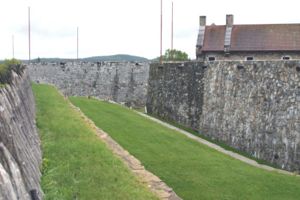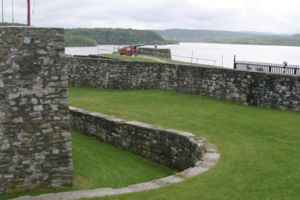Fort Ticonderoga: Difference between revisions
John Stanton (talk | contribs) No edit summary |
John Stanton (talk | contribs) No edit summary |
||
| Line 71: | Line 71: | ||
[[Category:Preserved]] | [[Category:Preserved]] | ||
[[Category:Must See]] | [[Category:Must See]] | ||
[[Category:New York Not Visited]] | |||
Revision as of 11:17, 8 January 2012
Fort Ticonderoga (1750-1796) - First established in 1750 by the French as Fort Vaudreuil, later rebuilt by them as Fort Carillon. Later named Fort Ticonderoga after the Iroquois word for the junction of two waterways. Captured by the British in 1759 and the Americans in 1775 and recaptured by the British in 1777. Abandoned by the British in late 1777 and by the Americans in 1796.
French & Indian War (1754-1763)
The original Fort Vaudreuil built in 1750 was a small stockade. In 1755 the French Govenor of Canada sent Michel Chartier de Lotbiniere to designed and construct Fort Carillon at the south end of Lake Champlain to prevent British access to the lake. Lotbiniere began construction of a small star shaped, Vauban style fort in October 1755 using troops stationed at nearby Fort St. Frederic. The fort grew to include:
- Reine bastion pointed northeast
- Germaine bastion pointed northwest
- Joannes bastion pointed south
- Languedoc bastion pointed south
- Two demi-lunes extended the works on the land side north and west.
- Lotbiniere redoubt, an outer work to the west provided additional land side coverage
- Three barrracks housing about 400 sodiers
- Four storehouses
- Powder magazine
The walls were seven feet high and fourteen feet thick. The wooden exterior walls were dressed with stone from a local quarry. The structures inside the fort were constructed of stone and most were higher than the seven foot walls. The fort was surrounded by a glacis and a dry moat five feet deep and fifteen feet wide. The fort was essentially complete by 1758 and armed with cannons from Montreal and Fort St. Frederic.
In Jul 1759 British General Jeffery Amherst captured Fort Carillon with a 11,000 man army and renamed it Fort Ticonderoga. General Amherst rebuilt and improved the fort. After the end of the French & Indian War the fort served as a storage depot for British arms.
Revolutionary War (1775-1783)
Early in the Revolutionary War, patriot forces under Ethan Allen and Benedict Arnold captured Fort Ticonderoga from a small British garrison. The captured British arms were later sent to support the siege of Boston and contributed to driving the British from the city. British GeneralJohn Burgoyne recaptured Fort Ticonderoga in July 1777 but abandoned it in October 1777, the departing garrison burned the fort. The fort was again repaired and garrisoned by the British in 1781. The 1783 Treaty of Paris ended the French & Indian War and the British withdrew, leaving the fort abandoned without an American caretaker force. In 1796, Columbia and Union Colleges were allowed to lease the land to private persons to generate income. In 1820, a private person, William Ferris Pell, bought the entire property and began a multi-generation restoration of the fort and the grounds.
Current Status
Restored. 2010 season closed. The 2011 Season begins 20 May 2011.
|
{"selectable":false,"width":"500"} |
Location: Essex County, New York. Maps & Images Lat: 43.841449 Long: -73.3876188 |
Sources:
- Roberts, Robert B., Encyclopedia of Historic Forts: The Military, Pioneer, and Trading Posts of the United States, Macmillan, New York, 1988, 10th printing, ISBN 0-02-926880-X, page 582-584
Links:
Visited: No
Fort Ticonderoga Picture Gallery
|
Click on the picture to see a larger version. Contribute additional pictures - the more the better! |


